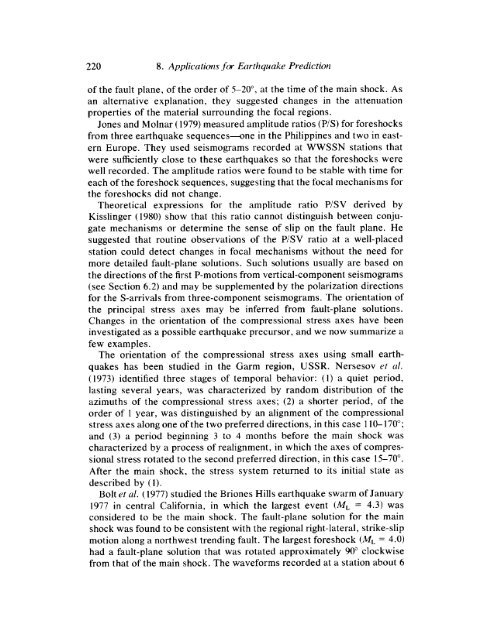principles and applications of microearthquake networks
principles and applications of microearthquake networks
principles and applications of microearthquake networks
Create successful ePaper yourself
Turn your PDF publications into a flip-book with our unique Google optimized e-Paper software.
220 8. Applications fw Earthquake Prediction<br />
<strong>of</strong> the fault plane, <strong>of</strong> the order <strong>of</strong> 5-20', at the time <strong>of</strong> the main shock. As<br />
an alternative explanation, they suggested changes in the attenuation<br />
properties <strong>of</strong> the material surrounding the focal regions.<br />
Jones <strong>and</strong> Molnar (1979) measured amplitude ratios (P/S) for foreshocks<br />
from three earthquake sequences-ne in the Philippines <strong>and</strong> two in eastern<br />
Europe. They used seismograms recorded at WWSSN stations that<br />
were sufficiently close to these earthquakes so that the foreshocks were<br />
well recorded. The amplitude ratios were found to be stable with time for<br />
each <strong>of</strong> the foreshock sequences, suggesting that the focal mechanisms for<br />
the foreshocks did not change.<br />
Theoretical expressions for the amplitude ratio P/SV derived by<br />
Kisslinger (1980) show that this ratio cannot distinguish between conjugate<br />
mechanisms or determine the sense <strong>of</strong> slip on the fault plane. He<br />
suggested that routine observations <strong>of</strong> the P/SV ratio at a well-placed<br />
station could detect changes in focal mechanisms without the need for<br />
more detailed fault-plane solutions. Such solutions usually are based on<br />
the directions <strong>of</strong> the first P-motions from vertical-component seismograms<br />
(see Section 6.2) <strong>and</strong> may be supplemented by the polarization directions<br />
for the S-arrivals from three-component seismograms. The orientation <strong>of</strong><br />
the principal stress axes may be inferred from fault-plane solutions.<br />
Changes in the orientation <strong>of</strong> the compressional stress axes have been<br />
investigated as a possible earthquake precursor, <strong>and</strong> we now summarize a<br />
few examples.<br />
The orientation <strong>of</strong> the compressional stress axes using small earthquakes<br />
has been studied in the Garm region, USSR. Nersesov et NI.<br />
(1973) identified three stages <strong>of</strong> temporal behavior: (1) a quiet period,<br />
lasting several years, was characterized by r<strong>and</strong>om distribution <strong>of</strong> the<br />
azimuths <strong>of</strong> the compressional stress axes; (2) a shorter period, <strong>of</strong> the<br />
order <strong>of</strong> I year, was distinguished by an alignment <strong>of</strong> the compressional<br />
stress axes along one <strong>of</strong> the two preferred directions, in this case 110-170";<br />
<strong>and</strong> (3) a period beginning 3 to 4 months before the main shock was<br />
characterized by a process <strong>of</strong> realignment, in which the axes <strong>of</strong> compressional<br />
stress rotated to the second preferred direction, in this case 15-70'.<br />
After the main shock, the stress system returned to its initial state as<br />
described by (1).<br />
Bolt et al. ( 1977) studied the Briones Hills earthquake swarm <strong>of</strong> January<br />
1977 in central California, in which the largest event (ML = 4.3) was<br />
considered to be the main shock. The fault-plane solution for the main<br />
shock was found to be consistent with the regional right-lateral, strike-slip<br />
motion along a northwest trending fault. The largest foreshock (ML = 4.0)<br />
had a fault-plane solution that was rotated approximately 90" clockwise<br />
from that <strong>of</strong> the main shock. The waveforms recorded at a station about 6






